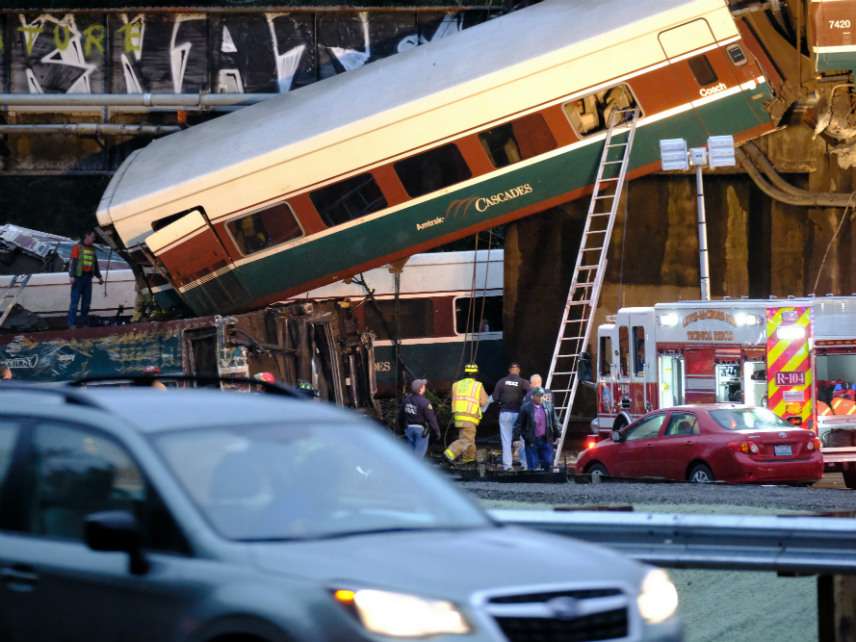Would More Infrastructure Spending Have Stopped Yesterday's Derailment?
President Trump seems to think so.

Would more infrastructure spending have prevented yesterday's deadly Amtrak derailment outside DuPont, Washington?
That seems to be Donald Trump's view. The president took to Twitter shortly after the accident—which left at least three dead and sent another 77 to the hospital—to plug his forthcoming infrastructure plan.
"The train accident that just occurred in DuPont, WA shows more than ever why our soon to be submitted infrastructure plan must be approved quickly," Trump tweeted. "Seven trillion dollars spent in the Middle East while our roads, bridges, tunnels, railways (and more) crumble! Not for long!"
The hot take from the president is premature given how little we know about the direct causes of the Amtrak derailment. It is also totally off-base, given that the accident occurred on the first day of service for a new line of track funded entirely by federal stimulus dollars intended to spur high-speed rail development.
The Point Defiance Bypass route—on which yesterday's tragic derailment occurred—was the recipient of $181.7 million in federal grants through the High-Speed Intercity Passenger Rail Program (HSIPR).
The funding came from the American Recovery and Reinvestment Act signed into law in 2009 by then-President Barack Obama. Obama was a major proponent of stimulus for high-speed rail, his administration allocating some $10.6 billion for nearly 150 HISPR projects.
According a factsheet put out by Obama's Federal Railroad Administration, this spending was a "strategic investment" that "will help ensure America is equipped to win the future with the fastest, safest, and most efficient transportation network in the world." The same factsheet bragged the spending on rail between Portland and Seattle will come with "numerous safety improvements."
Indeed, the Obama Administration was so enthusiastic about high-speed rail that it did not request state or local matching funds for many of it's HISPR projects. This includes the Point Defiance Bypass project, which a Washington Department of Transportation spokesperson told Reason was entirely federally funded.
The bypass was a new 14.5-mile line of track intended to relieve congestion on the current railway lines between Portland and Seattle—which are also trafficked by freight and commuter rail trains—allowing for more daily passenger rail service between the two cities. Amtrak Cascade 501—the train from yesterday's crash—was servicing the inaugural passenger trip of the new line.
So if the story of yesterday's crash is not decrepit infrastructure breaking down and costing lives, what is it?
The only explanation so far is speed. National Transportation Safety Board member Bella Dinh-Zarr said, in a Monday night news conference, the train in question was traveling 80-mph in a 30-mph zone, before it jumped the tracks.
Atlantic and CNN have suggested in pieces today we need to spend more, not on new tracks, but on new safety programs, especially on something known as Positive Train Control or PTC.
PTC is a kind of autopilot for trains, specifically "designed to automatically stop a train before certain accidents caused by human error occur," according to the Association of American Railroads. This includes accidents caused by excessive speed.
The section of track on which yesterday's derailment occurred was equipped with PTC, but was not supposed to be operational until the second quarter of 2018. Congress required railroads to implement PTC in in 2008, but have allowed them until 2018 to get the job done.
Interestingly, one of the criteria for receiving grants under the HSIPR program is that projects encourage the implementation of PTC technology.
So far, the NTSB has been non-committal on whether PTC would have prevented yesterday's derailment, with Dinh-Zarr saying only that "PTC would prevent types of accidents such as this. Whether it will prevent this accident remains to be seen."
With so much still unknown about the derailment, calls for more spending on safety infrastructure or more infrastructure in general are premature. Indeed, one of the positive features of Trump's infrastructure plans (what we know of them anyway) is that they will focus less on white elephant rail projects, and more on necessary infrastructure improvements that can fund its own upgrades through user fees and private partnerships.
Using yesterday's derailment to advocate for such a plan is both tasteless and ill considered.
Rent Free is a weekly newsletter from Christian Britschgi on urbanism and the fight for less regulation, more housing, more property rights, and more freedom in America's cities.


Show Comments (87)